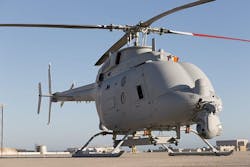Northrop Grumman to build five new MQ-8C Fire Scout unmanned shipboard helicopters in $55.1 million deal
PATUXENT RIVER NAS, Md. –Unmanned aerial vehicle (UAV) designers at Northrop Grumman Corp. will build five long-range unmanned helicopters for operation from destroyers and other surface warships under terms of a $55.1 million U.S. Navy contract announced Wednesday.
Officials of the Naval Air Systems Command at Patuxent River Naval Air Station, Md., are asking the Northrop Grumman Aerospace Systems segment in San Diego to build five MQ-8C Fire Scout vertical take-off and landing tactical unmanned aerial vehicles (VTUAV), which are based on the manned Bell 407 helicopter from Bell Helicopter Textron Inc. in Fort Worth, Texas.
The contract for the unmanned helicopters includes two lightweight fuel cells. The manned version of the Bell 407 seats seven, can carry a useful load of 2,347 pounds, flies as fast as 140 knots, and has a range of 324 nautical miles.
The original MQ-8A and MQ-8B versions of the Navy Northrop Grumman Fire Scout UAV are based on the Schweizer 333 helicopter from Schweizer Aircraft Corp., now owned by Rotorcraft Services Group in Fort Worth, Texas.
The commercial version of the Schweizer 333 seats three, can carry a payload of 1,250 pounds, can fly as fast as 105 knots, and has a maximum range of 319 nautical miles. The MQ-8B is limited to operating for eight to 12 hours per day of ISR coverage at a range of 100 nautical miles, Navy officials say. To meet the longer-range requirements, Northrop Grumman experts will use the avionics developed for the MQ-8B, as well as the software and ground-control systems, on the longer-range MQ-8C Fire Scout based on the Bell 407.
The MQ-8C will provide the Navy with an increased range of more than 30 percent, twice the endurance, and an increased payload capacity over the existing MQ-8B variant, Northrop Grumman officials say. The unmanned systems architecture developed for the MQ-8B is re-used in the Bell 407.
The primary advantage of the MQ-8C Fire Scout over its MQ-8B and MQ-8A versions is the newest shipboard UAV has double the useful payload of its predecessors. The newest model also has a somewhat faster top speed and slightly more maximum range than previous models of the Fire Scout.
Manufacturing and assembly operations of the new Fire Scout variant are at Bell's facility in Ozark, Ala., and final assembly is Northrop Grumman's Unmanned Systems Center in Moss Point, Miss.
On the contract awarded Wednesday, Northrop Grumman will do the work in San Diego; Ozark, Ala.; Fort Worth, Texas; Moss Point, Miss.; and other U.S. locations, and should be finished by August 2021.
For more information contact Northrop Grumman Aerospace Systems online at www.northropgrumman.com, Bell Helicopter Textron at www.bellflight.com, Rotorcraft Services Group at http://rotorcraftservices.com, or Naval Air Systems Command at www.navair.navy.mil.
Ready to make a purchase? Search the Military & Aerospace Electronics Buyer's Guide for companies, new products, press releases, and videos

